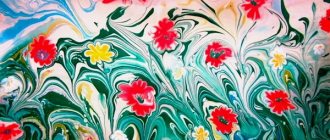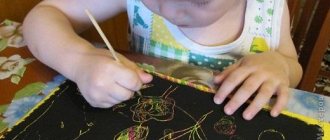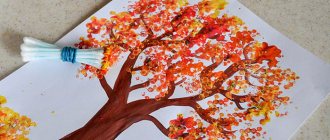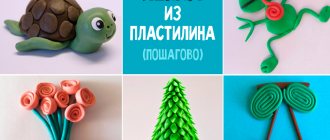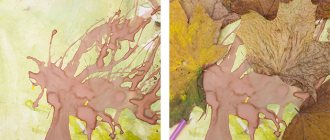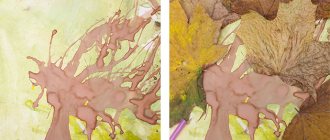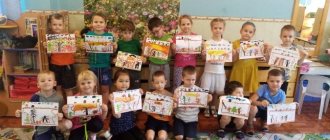How diverse the world of art is! He has no boundaries and generously accepts any ideas, turning them into a separate direction of creativity. One of them is monotype - a drawing technique that combines printed graphics and painting, but is not an engraving.
The artist applies an image with a brush to a flat metal surface, from which the design is imprinted onto damp paper under the pressure of an etching press. This design is unique because... its replication is impossible: only one high-quality print can be obtained from a flat form.
In this article we will tell you where this type of art comes from, what types of monotype there are, and how to learn this drawing technique yourself. Welcome to the world of monotype!
The history of the appearance of monotype
Monotype, translated from Greek, literally means “one print,” but, judging by historical data, it did not originate in Greece: the first engraving prints without a black outline appeared in the 11th century in China. These were the simplest types of monotype.
For a long time, monotype was an additional technique to the main graphic techniques. The first color print was made by the Dutch artist Hercules Seghers: he painted over metal engravings (etchings) with colored paints. This is how unique prints were obtained, which served as the beginning of the development of this type of art.
This technique of depicting a drawing was adopted and improved by the Italian artist and graphic artist Giovanni Benedetto Castiglione. It is he who is credited with the invention of monotype. Castiglione painted the plate with ink and, after the paint had completely dried, cut out the image with a sharp tool and printed it on paper.
“The Creation of Adam” is one of the most famous monotypes of the Italian painter. The painting depicts God emerging from a cloud with white angular strokes. And in the darkness, Adam is depicted with thin flowing lines. This masterpiece was created using black ink, a plate and a blunt instrument (stick or brush handle) [Art Institute Chicago, 2020]:
More than a hundred years later, the English artist, engraver, poet William Blake contributed to the development of monotype: he varnished the drawing on a copper board. He filled the areas empty of varnish with acid, so that the outline of the design protruded above the smooth background. Next, Blake transferred the drawing with a print to the board. This is how zincography appeared - a convex etching.
Despite all the artistic experiments, monotype began to emerge as a separate direction only in the 19th century thanks to Edgar Degas, a French artist. He created many works using this technique. Degas loved to experiment: he was the first to use a transparent board in a monotype; it made it easier to control the work process.
The artist published manuals on monotype, presented his works at exhibitions, and the circle of those interested in monotype began to gradually expand [N. Kuznetsov, 2010].
In Russia, Elizaveta Kruglikova is considered the founder of monotype. While in Paris for about 25 years, she created about five hundred prints on various subjects. The largest series of works made using the monotype technique is the “Flowers” series; it includes more than a hundred prints [P. Kornilov, 1969].
In the 20th century, color and the material used began to take on special importance in art. Thus, Yuri Velikanov, a student of Elizaveta Kruglikova, created monotypes dedicated to the construction of a power plant on the Svir River.
Monotype gained particular popularity in the 1930s. Using this technique, Anatoly Suvorov created illustrations for Alexei Nikolaevich Tolstoy’s story “Nikita’s Childhood”:
Ada Rybachuk, an artist from Ukraine, came to the North in 1950 and was struck by the beauty of nature, which served as an incentive for inspiration and painting using the monotype technique. She created illustrations for the fairy tale “Little Unyany”:
Artists of the 20th century experimented in their creativity, worked with colored paints and found non-standard methods for performing monotypes. Vadim Frolov, an engraver, used waste from metal production in his works, and Valery Mishin, an artist from St. Petersburg, used real objects to create prints: plants, buttons, needles, snaps, etc. This is how the monoprint appeared.
Mikhail Tarkhanov, a graphic artist and designer, poured oil paints over water and then placed a sheet of paper on top. Using watercolor, ink, and pencil, he completed the missing images on the dried canvas. This is how a new direction of monotype appeared - aquatype.
Another original way of applying a picture was invented by Gennady Troshkov: he applied paints to glass or lithographic stone, and then transferred this paint to paper using a soft roller.
As you can see, since the advent of monotype, this type of creativity has undergone significant changes. Artists used various methods of drawing, which led to the emergence of new directions in the monotype technique. Let's look at each of them in more detail in the next section.
Types of monotypy
Monotype is a multifaceted art form. The authors use various technical techniques that help to most accurately convey the artist’s idea.
There are several criteria that divide monotypy into types:
- Color solution: monotype can be monochrome or polychrome. Monochrome monotype is most often done with black printing or offset ink.
- Method of applying the design: the design is applied to a clean form or by removing paint residues from the base.
- Type of printing form: the design can be applied to wood, glass, plastic, metal.
- Type of print base: a print of a drawing can be made on canvas, cardboard, or paper.
- Art materials : watercolor, ink, oil, acrylic, etc. are used for drawing. [Very Important Lot, 2020].
Monotype is a great way to develop creativity for both adults and children. Today, several varieties of this image technique have appeared:
- Aquatype: the picture is applied with gouache, and then the areas free from paint are painted over with black ink. Next, the painted sheet must be dried and then placed in a container with water. Mascara does not dissolve in water, but gouache does not dissolve partially. The result is the original blurry image:
- Deotype: a sheet of paper is placed on a form with paint, and thin tracing paper is placed on top. A drawing is applied to the tracing paper using a pencil or any other object. As a result, the paint is imprinted unevenly on the paper and an interesting pattern is obtained:
- Negative monotype: to create it, a form with remnants of paint that was used in deotype is used. Unpainted areas are re-painted and a new print is made on paper:
- Aquagraphy: insoluble paint in liquid form is slowly added to a container of water. Colored pigments will form on the surface, which must be mixed with a brush, creating interesting patterns. Then a sheet of paper is placed in a container of colored water to make an imprint of the pattern, and it is carefully removed. By the way, this method of depicting a picture appeared in the 15th century. In Turkey and Persia, aquagraphy was called ebru (" cloud art "):
- Florotype: paint is applied to the form, and petals, flowers, leaves are laid out on top and covered with paper. an interesting imprint remains on the paper with the silhouettes of the objects used:
- Decalcomania: a colored design is transferred from paper under pressure to a fabric surface, ceramics or other canvas. This technique is most often used to print a decal:
- Blotography: this is one of the easiest techniques to create a monotype image. Anyone can handle it: watercolor or gouache is poured onto the center of a sheet of paper, and then the paper is tilted in different directions so that the paint spreads over the surface, forming colored streaks: [Very Important Lot, 2020].
It is no coincidence that monotype is classified as a non-traditional drawing technique. The methods for creating images are striking in their originality and at the same time simplicity. I just want to try to draw something like this using one of the methods described above. And you?
Monotype techniques
Drawing using the method in question has a long history. During this time, several different working techniques emerged.
Subject monotype
The simplest technique can be used as follows:
- The drawing is done on a sheet of paper.
- It is folded in half, forming a fold line.
- On one of the halves, paint half of a simple object, for example, a cube.
- The paper is then folded, creating a complete picture.
Landscape monotype
Older kids can create landscapes. In this case, they draw part of the image on half of the paper, fold it and get the full picture. Thus, in particular, it is convenient to draw a forest on the shore of a lake and its reflection in the water.
Winter landscape
Other monotype techniques
To perform the next technique, you must already have basic skills. In this case, a plastic sheet is used. Dark paint is applied to it. While it retains its moisture, the child moves a cotton swab over it. Then they apply a sheet of paper and get a picture drawn with light paint on a dark background.
Baby learns a new drawing technique
Another technique can be used when the drawing is made by applying dark paint to a light surface with a brush.
On a note! Another subject technique can be used. In this case, the sheet of paper is crumpled before drawing on it. As a result, new features will be added to the resulting print, allowing you to see the image with more texture.
Non-traditional drawing technique for the middle group of kindergarten
There is a non-standard use of this technique. Here the presentation is created in two stages:
- First, make a background image on a piece of paper.
- After the paint has dried, the child completes the drawing on it.
The work is done this way:
- You need to prepare a bowl of water, linseed oil, oil paint, a solvent for it and a brush that will be used for stirring. You need containers in which to mix the paint.
- For each desired color, this procedure is carried out separately. A little paint is poured into the jar, solvent and linseed oil are added. Then this mixture must be thoroughly stirred.
- The mixture is poured from the jars into a bowl of water. Linseed oil allows paints to float
- Use a brush to gently mix the liquid.
- Then a sheet of paper is placed under water and slowly raised. The paint drips off it, leaving beautiful and unexpected shapes.
- Then you need to wait until the paper dries.
On a note! Multi-colored stains will be visible on the sheet, which form unusual patterns or fantastic figures. The child can modify the drawing at his own discretion.
Monotype in psychology
Monotype is not just a drawing technique, because... today it is a type of art therapy that will be useful to absolutely everyone who needs to stabilize their psycho-emotional state. This method of psychotherapy has long been loved by psychologists, because, if used correctly, it will bring obvious benefits in the form of:
- relieving emotional stress;
- development of individuality;
- strengthening interpersonal connections;
- actualization of feelings;
- development of thinking, creativity;
- spontaneous self-expression [M. Kiseleva, 2007].
The most famous method of studying the psyche of an individual and its disorders using monotype is the psychodiagnostic text of Hermann Rorschach (“Rorschach’s Blots”).
The author of the test drew 10 blots of different colors and saturation, each image serves as a stimulus for free associations. According to Rorschach, what the subject sees in these images indicates his intellectual control and emotional state. For the purity of the study, the test taker must answer the following questions:
- What does he see in the picture?
- Where does he see this?
- Why does the ink blot evoke such associations in him?
Here is an example of one of the test images:
What do you see in the picture? This image evaluates a person's attitude towards other people. Most often, subjects answer that they see a moth, a butterfly, two people, or a person looking in the mirror.
If you see two people talking, then you have an active social life. If you feel like they are washing their hands, then you may not feel safe. And if it seems to you that two people are playing some kind of game, then most likely you are now subject to competition [B. Bely, 2005].
Monotype is especially useful for children. It plays an important role in studying the psychological state of the child and developing his creative skills. Many children love to draw with paints, so the process of creating a drawing using this technique fascinates them very much. Monotype contributes to:
- development of fine motor skills;
- stabilization of the emotional background;
- speech development;
- broadening the horizons of children;
- normalization of the nervous system;
- formation of perseverance, perseverance, attentiveness, etc. [M. Kiseleva, 2006].
To begin with, you can use a simple sheet of paper and paint: let the child draw what he can, and then, while the paint is still wet, cover the painted sheet of paper with a clean sheet. The end result will be a funny picture.
This kind of creative activity can be easily organized at home. In kindergartens, for this purpose, plexiglass or plastic boards are used, on which an image is applied with gouache or oil paints and then printed on paper. The resulting picture is complemented by a drawing with a brush or pencil.
Monotype is included in the curriculum of fine arts lessons. In elementary grades, children draw with their fingers or palms, while older students use other techniques and materials.
An interesting creative exercise “Frosty Patterns” is offered by psychologist Galina Elchaninova. To do this you will need sheets of paper, gouache, gel paints, threads, a plastic bag, and a tube. First, dip the brushes into jars of paint and apply spots on the bag. Next, put paper on it and press tightly. On the resulting print, before the paint has dried, we lay out patterns using thread, tubes, etc. The result is an improvised winter pattern.
This technique can reflect absolutely any theme, be it summer, spring, or just free creativity. The main thing is the absence of restrictions [G. Elchaninova, 2018].
Monotype is an excellent way to develop sensory-perceptual perception. Here is another exercise that psychologists recommend doing with children: you will need liquid gouache, water, paint cups, vegetable oil, flour, PVA glue, salt, cardboard, oilcloth.
To begin with, children make their own paint: mix 100-150 grams of flour, a tablespoon of vegetable oil, a pinch of salt, a tablespoon of glue and add water so that the consistency resembles sour cream. It is important that all components are mixed by hand. Next, the child’s favorite color is added to the resulting mixture.
Ask children to comment on how they felt during the process. After this, give the task to paint with your hands on cardboard or a sheet of paper with the resulting paint. This can be individual or collective creativity.
Don’t be afraid to experiment with monotype: the more varied the activities, the more interesting they will be for children. an unusual execution of monotype in her book “Creative Workshop: 55 Master Classes for Little Explorers”: take paints, water, paper, soap and straws. Mix gouache and soap in water in a ratio of 1:2:2.
Invite your child to blow into a tube lowered into a glass of colored soapy water until a cloud of bubbles forms on the surface. Place the paper on the bubbles. It will be more interesting if there are several similar solutions and they are all of different colors [R. Dorley, 2016].
If you have any difficulties in conducting such creative activities, you can always turn to pedagogical materials for help. There are many notes on monotype on the Internet for teaching lessons to children of different ages.
Examples of drawings by preschoolers using the monotype technique with comments on how to complete the work
The butterfly is one of the most popular objects depicted using the monotype technique. Each work is unique. A variegated pattern distinguishes the butterfly in the “Beauty Butterfly” drawing; the outline of the silhouette is outlined with a felt-tip pen, which makes the drawing even brighter. “Moth” has a delicate, mysterious color in yellow and blue tones. The compositions “Sunny Butterfly” and “Blue Butterfly” are decorated with additional details: the sun, grass, flowers. The butterflies themselves here have an interesting wing shape. The butterfly in the drawing “Beautiful Butterfly” looks original and elegant: this effect occurs due to a combination of two unconventional techniques - monotype and leaf printing (the antennae are painted in with watercolors).
Photo gallery “Butterflies using monotype technique”
Watercolor drawing
Drawing with watercolors and felt-tip pen
Watercolor drawing
Watercolor drawing
Watercolor drawing
A combination of two unconventional techniques - monotype and leaf printing
Charming sea inhabitants that look like magical creatures are depicted in the drawing “Fish”. Let us note the very beautiful background of the composition; the seabed with algae is realistically and at the same time magically conveyed. A threatening looking fish is shown in the “Sawfish” picture. The drawing “Fish in an Aquarium” turned out to be unusual. Their color complements each other: red with white spots and vice versa white with red spots.
Photo gallery "Fish"
Watercolor drawing
Gouache drawing
Watercolor drawing
Using the monotype technique, very beautiful flower bouquets are obtained. A bright composition with yellow-red buds is presented in the picture “Bouquet for Mom”, and “Vase with Flowers”, on the contrary, is made in delicate pastel colors. A mysterious and mysterious plant is the work “Magic Flower”.
Photo gallery "Flowers"
Watercolor drawing
Watercolor drawing
Watercolor drawing
Landscape works made using the monotype technique are always fascinating. You can look at them for a very long time. Drawings with horizontal symmetry are, as a rule, trees reflected in a body of water (lake or river). In this regard, the compositions “Beautiful Trees”, “Forest over the River”, “Colors of Autumn” are interesting. Works with vertical symmetry are individual beautiful trees (drawings “Spreading Tree”, “Tree with Pears”. Also, the composition “Apple Orchard” looks charmingly summery - it amazes with its multicolored colors. Interesting variations on the winter theme are “New Year Tree" and " Winter miracle."
Photo gallery “Landscape compositions”
Watercolor drawing Watercolor drawing
Watercolor drawing
Watercolor drawing
Watercolor drawing
Watercolor drawing
Watercolor drawing
Watercolor drawing
Children's works by design are of great interest. A child’s imagination, combined with the monotype technique, sometimes creates the most unexpected and bizarre images. So, the “Pink Bull” looks mysterious, from which it emanates kindness. The drawing “Cheerful Sun” creates an anthropomorphic image of the sun with big eyes and a smile. The “Queen of Light” is charming and mysterious. And the “Running Bunny” differs from an ordinary animal with its vague, unusual figure. Cheerful twin sisters smile at us from the composition of the same name. And for some reason the “Merry Ducklings” turned away from each other.
Photo gallery “Fantasy motives”
Watercolor drawing
Watercolor drawing
Watercolor drawing
Watercolor drawing
Drawing with watercolors and felt-tip pen
Watercolor drawing
In the senior preschool level, children enjoy fantasizing about space themes. With the help of monotype, bizarre fantastic images of aliens are created - the inhabitants of Mars, Jupiter, Saturn. Children even come up with names for them and write them on the drawing. Let us note that all the creatures, each unusual in its own way, have a good-natured appearance, because the majority of children’s works are always positive.
Photo gallery "Space"
Watercolor drawing
Watercolor drawing
Drawing with watercolors and colored pencils
Watercolor drawing
Watercolor drawing
The more diverse and interesting the techniques and techniques of visual activity when working with preschoolers, the more the children’s artistic abilities develop. In this regard, monotype is truly a magical way of drawing. In the perception of children, it is similar to a fairy tale or a magic trick. The original technique allows the creative nature to reveal itself, which leads to the most unexpected results: the child will admire his drawing and want to draw again and again.
Let's start practicing
The advantage of monotype is that absolutely everyone can do it. To learn how to draw in this technique, you do not need to have an artistic education or a rich imagination; you just need to stock up on time and some tools, such as:
- Base: To start, you can use thick paper or cardboard. The main thing is that the surface is not saturated with paints. Glass, metal plates, and plastic surfaces are suitable as a base.
- Paints: It is best to use acrylic paints, because... they are distinguished by bright colors and dense texture, the images are more saturated and interesting, gouache is also suitable.
- Drawing supplies: usually paint is applied with brushes and a roller, and for drawing details, cotton swabs, tubes, toothpicks, pencils, in a word, anything that has a pointed end is suitable.
- Additional materials: to create more original images, you can use fabric as a base, and to add texture to the design - any available materials, twigs, leaves, etc.
One of the main principles of monotype is specularity. The drawing is obtained by imprinting paint from the base onto another surface or, in the simplest way, from one half of the paper to the other. Another important point - do not overdo it with the amount of paint, otherwise the drawing will resemble blots.
Monotype is a technique that allows you to create a unique print. It will not be possible to replicate a drawing: only one print can clearly convey the image. Despite its simplicity in execution, you should start with simple images and drawing techniques. There are several monotype techniques that you can easily handle:
- Subject monotype : using this technique, you can draw any object by symmetrically transferring an image from one half of a sheet of paper to the other. It's very simple: first we bend a sheet of paper in half, unfold it and draw on one side, for example, a tree trunk. Next, fold the paper in half again: the design is imprinted on the blank side of the sheet. This way you can finish drawing the leaves on the tree, the sky, the background, etc.
- Monotype “Butterfly” : on one part of a sheet of paper we draw colored spots, the outline resembling the wings of butterflies. We print the colored part of the sheet on the blank half. The result is a bright outline of the butterfly; the contours of the wings, patterns and antennae can be completed with a pencil.
- Landscape monotype : on one side of a sheet of paper we draw a landscape and print the drawing on the opposite side of the sheet. The resulting picture can be completed and made clearer and more organic. Look how beautiful the monotype on the theme “Spring” looks:
- Monotype “Flowers” : paint over a sheet of paper with white ink, draw stripes of pastel colors on top, and then use a wide brush to shade the colored lines with white paint. Make a vase of flowers the central figure of the image. You can choose shades according to your taste. Once the image is completely applied, wet another sheet of paper and press firmly onto the design. You will get a picture with original streaks [L. Savchuk, 2018].
You can execute this monotype using the previously described methods, by depicting part of the design on one side of the paper and simply printing it on the other.
Even a child can handle such techniques, but despite the simplicity of the process, both adults and children will enjoy creating an image. The main thing is to make prints before the paint dries.
If you are ready to experiment, in addition to the above-mentioned materials, use glass, rollers, and plastic. Apply paint to the glass with a roller or brush. If you want an interesting texture, use hard brushes. You can remove excess paint with a napkin and complete the missing details. Then, while the paint is still wet, cover the glass with a sheet of paper and go over it thoroughly with a roller. A few minutes of creative flight and the picture is ready.
There are many video tutorials and master classes that will help you quickly master this drawing technique. Look at this one for example :
If you have long wanted to learn how to draw, but until now you thought that only the gifted could do this activity, we advise you to take our online course “Drawing”, where you will learn how to create your own works of art and forever cast aside all doubts about your creative abilities. We recommend!
Drawing using the monotype method in kindergarten
Important! When using monotypic drawing, children produce drawings, each of which is unique.
These lessons can be included in the educational plan or organized as a circle.
You can start classes in kindergarten using the monotype drawing technique as early as the second junior group. At this age, children are asked to depict simple and well-known objects. Here are a few such examples:
- air balloons;
- cubes;
- fish;
- checkboxes.
Usually kids are asked to use a sheet of paper folded in half. First, make the design on one side, then fold it in half. The drawn image is printed on the other side.
On a note! Sometimes the design is applied so that it touches the fold line. After folding the page, a symmetrical image is obtained.
If it is difficult for a child to make a drawing, you can prepare a template for this.
Bouquet of flowers
At an older age, children are asked to draw more complex drawings. For creativity, watercolors or gouache are used. The first of them should not be diluted too much. In some preschool educational institutions, drawing classes are conducted using acrylic paints. However, in this case, you need to take into account that they dry quickly and cannot be washed off if you want to correct the drawing.
Observations during a walk in the second junior group
To conduct classes in kindergarten on creating images, you can use the following materials:
- sheets of thick paper or thick glossy paper;
- when teaching preschool children, you can use film;
- A plastic board is suitable for drawing;
- glass;
- You can use tiles.
Other options for performing the work are also possible.
Summarize
Monotype is one of the oldest forms of art, which has greatly transformed in our time and has found its application not only in creative fields, but also in psychology. This is a unique method of drawing that does not have any restrictions.
You can use all possible materials: paper, plastic, glass, metal and any available means; The main thing to remember is that speed and mood are important in this matter.
Monotype is compared to meditation, and it is not for nothing that this technique is widely used in art therapy. To master this type of creativity, no special preparation is required, and each of you will probably have the materials necessary for drawing at home.
This activity will be exciting for both adults and children, so don’t deny yourself the pleasure of plunging into the world of creativity. And, if you have long wanted to try yourself as an artist, we recommend starting with monotype, because it is fast, simple and very exciting.
We wish you creative inspiration!
We also recommend reading:
- Storytelling
- How to learn to understand works of art
- A selection of useful materials about creativity and creativity development
- Euler circles
- Lettering: art in letters
- Lettering: freedom of speech for the artist
- Profession artist
- 10 most famous artists
- "The hands resist him." History of the pattern causing Stendhal syndrome
- What is neurography and how is it useful?
- Neuroaesthetics: what is it and what does it do?
Keywords:1LLL
